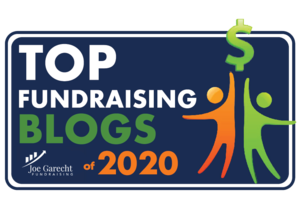It’s budget time. And the debates begin. How much budget to allocate for fundraising? How much for communications? How much for marketing?
And those debates migrate to who owns each of the functions.
One non-profit leader believes that it all belongs together, and that marketing and communications belong in the fundraising management group.
Another leader, who has come out of a commercial marketing background, argues that communications and marketing should be a separate function from fundraising. Fundraising, she says, is about getting donors and money, while marketing and communications is about promoting, enhancing, and protecting the brand.
A third leader, who comes from a communications background, feels strongly that the communications function should be the main driver of fundraising and marketing messaging, and therefore it needs a seat at the management table to make sure that happens. After all, he says, fundraisers are not as good at the whole communication thing – they need expert help.
The outcome of these competing points of view is an organization structure and budget that, in our opinion, is off-point and ineffective in accomplishing the dual task of raising funds for program and promoting the brand. And that means a lot of wasted money and division between staff in these departments who are bickering and infighting about what is right and who gets to do what.
The result? Here are a few examples:
- The communications department is tasked with producing the annual reports, which are pretty, but are devoid of any impact reporting (how a donor’s gift caused change), fail to include any set up for an ask, and lack the level of emotional impact needed to motivate the reader to get involved and give.
- The marketing department is given the responsibility to create advocacy campaigns that increase awareness. They are rewarded for increasing open and click rates and are ecstatic when peers in the marketplace notice their creative ads, promos, and emails. They have no responsibility for generating financial resources and think about fundraising communicators as a slightly lower class of communicators. After all, they say, those fundraisers are dealing with that emotional stuff, and their communication pieces are rather basic, lacking polish and sophistication.
- The fundraising function must rely on marketing and communications to provide resources for fundraising. But many of those collateral pieces, websites, email campaigns and other digital media efforts don’t work because the creative staff in those departments don’t understand how fundraising works.
All the above ways of operating cause dysfunction and confusion.
And more importantly, they are the root cause for the organization’s lack of fundraising success. Why? Here are the three main reasons:
- There are conflicting objectives. There is not an overall strategic plan that pulls these different functions together to work toward the same objective.
- There are conflicting skill sets in the labor pool. And each of those skill sets are seeking to find expression. This is normal, but it creates negative and competitive energy in the culture.
- This set up wastes precious resources, which means there is less budget for fundraising. And less money for fundraising translates into less net revenue for program.
Non-profit leaders and managers regularly manage these functions in this way. Jeff and I have seen it over and over again in large organizations and small.
And the main reason this happens is that these decision makers do not understand how fundraising works.
Because if they did, they would understand that the marketing and communication functions fit naturally into a good strategic fundraising plan. Here’s what I mean:
- The main purpose of a non-profit is to address a societal need. This could relate to people, the environment, animals, systems, etc.
- A non-profit needs resources to fulfill its mission. The major resource is financial. A secondary one is volunteers, which provide no cost or low-cost labor to help the non-profit fulfill its mission.
- Financial resources come from acquiring donors of all types: individual and institutional donors.
- An effective strategy for acquiring donors is to cause awareness of the need, create desire to DO something about meeting that need, and provide a way for the donor to give. This three-point approach should happen all the time in all media channels. Sometimes the ask component will be “louder” and more apparent; other times it will be softer… but it will always be there.
The point here is that in this strategy and approach, all the fundraising, marketing, and communication efforts are collapsed into one integrated effort that is focused on acquiring donors. This approach not only acquires the donor but also satisfies the need to enhance and protect the brand.
Why would you do this any other way? Because that’s how you did it at the last place you worked out in the commercial world, so it makes sense to do that here. No, that’s not a good reason. In fact, it’s a flawed reason – one that must be changed.
Don’t keep buying into this wrong way of doing non-profit communication and marketing. Decide today to integrate the functions in a focused way into the broader fundraising agenda. You will be glad you did as you experience an influx of more net revenue and increased fundraising success.
Richard
![The Confusion Around Marketing, Communications, and Fundraising Hands holding interlocking gears that represent fundraising functions [The Confusion Around Marketing, Communications, and Fundraising]](https://veritusgroup.net/wp-content/uploads/2023/05/AdobeStock_291546127-scaled.jpeg)






This is how our organization works! I work daily with the Director of Marketing. I am Director of Philanthropy. We work together on communication pieces, appeals. I don’t know what I’d do without her. Integration works!
Yes! Collaboration is the key. Thanks for reading, Christina. Wishing you continued success!
We have a VP of Marketing, Communications and Philanthropy. I am the Director of Fund Development. Everyone reports to her. It has become very dis functional because she is not a fundraiser and too much of her time is taken up on all staff reporting to her. I view marketing and communications as two separate entities but collaboration is a must. Any suggestions?
This is really tricky! Here’s another blog that has some guidance: https://veritusgroup.net/your-non-profit-organizations-structure-is-harming-your-mission-impact/
And we do help organizations assess and identify a better organization structure. You can reach out to Amy Chapman (achapman@veritusgroup.net) to learn more about that service if you’re interested.